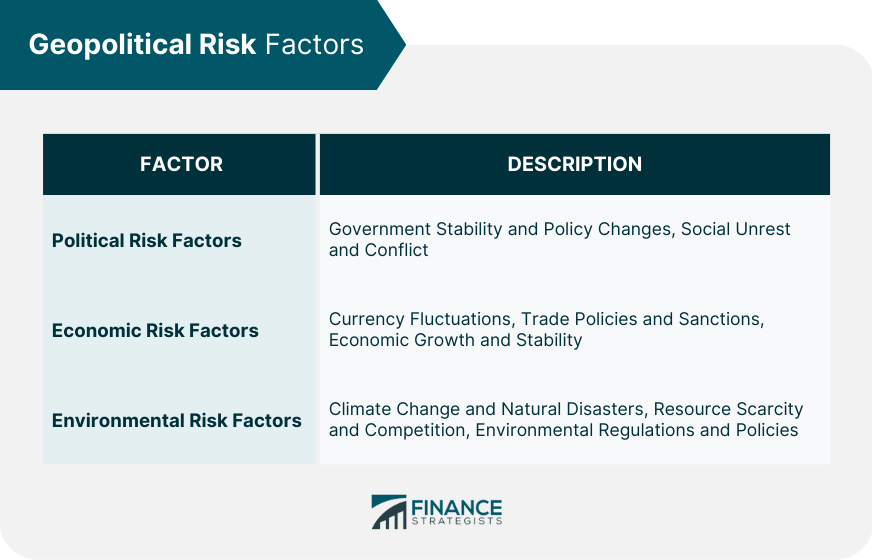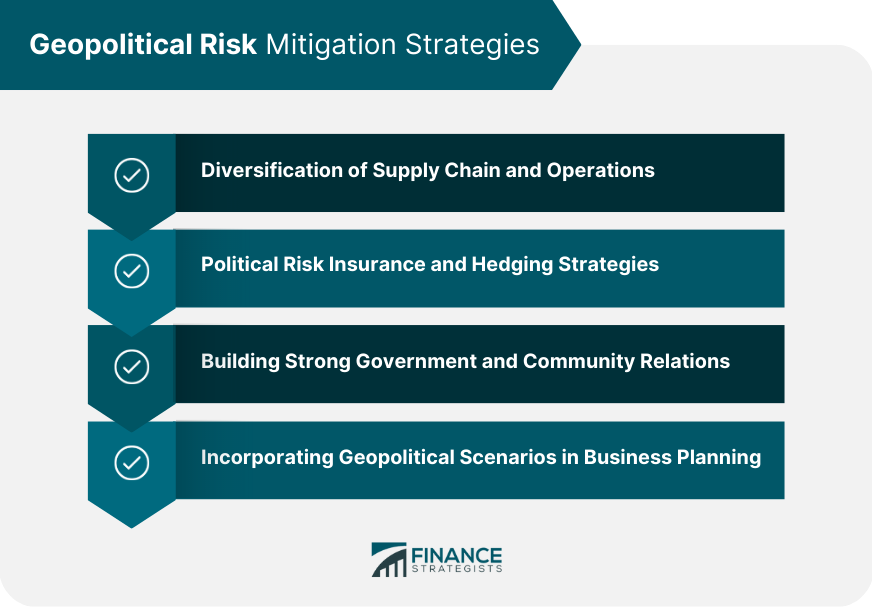Geopolitical risk management refers to the process of identifying, assessing, and mitigating the impact of geopolitical events on businesses and investments. It is crucial for organizations to manage geopolitical risks to maintain their competitive advantage, secure supply chains, and ensure business continuity. As the global landscape becomes more interconnected and complex, businesses need to be proactive in their approach to managing geopolitical risks. A well-planned strategy can help organizations navigate uncertainties and adapt to changes in the global environment. Effective geopolitical risk management consists of several key components. These include a comprehensive understanding of risk factors, regular monitoring and forecasting of events, and the development of strategies to mitigate potential impacts on the organization. By incorporating these components into their risk management framework, organizations can better prepare for potential disruptions and capitalize on opportunities arising from geopolitical shifts. This can ultimately contribute to the long-term resilience and success of the business. To effectively manage geopolitical risks, it is essential to understand the various factors and categories that contribute to these risks. This section will discuss political, economic, and environmental risk factors that can impact businesses. Political risk factors encompass a wide range of issues that can affect the stability of a country and the business environment. Government stability and policy changes can significantly impact business operations and investments, as changes in regulations or leadership can create uncertainties or disrupt the business environment. Social unrest and conflict, on the other hand, can lead to disruptions in supply chains, damage to infrastructure, and pose threats to the safety of employees. Economic risk factors are closely tied to the overall health and stability of a country's economy. Currency fluctuations can lead to increased costs for businesses, impacting profitability and competitiveness. Trade policies and sanctions can create barriers to market entry or disrupt global supply chains. Lastly, economic growth and stability are crucial for businesses, as they influence consumer demand and the overall business climate. Environmental risk factors involve issues related to the physical environment and natural resources. Climate change and natural disasters can disrupt supply chains, damage infrastructure, and impact the availability of resources. Resource scarcity and competition can lead to increased costs and geopolitical tensions, affecting businesses' operations and investments. Environmental regulations and policies can create new compliance requirements, increasing operational costs and impacting business strategies. To effectively manage geopolitical risks, organizations must first identify and assess potential risks. This section will discuss quantitative and qualitative risk assessment methods, geopolitical risk mapping, and monitoring and forecasting geopolitical events. Quantitative and qualitative risk assessment methods are essential tools for identifying and evaluating geopolitical risks. Quantitative methods involve the use of numerical data and statistical models to estimate the probability and potential impact of geopolitical events. Qualitative methods, on the other hand, rely on expert judgment, scenario analysis, and stakeholder input to assess geopolitical risks. By combining both quantitative and qualitative methods, organizations can gain a comprehensive understanding of potential risks and their impacts on the business. Geopolitical risk mapping and analysis involve visualizing the geographical distribution of risks and their potential impacts on an organization. This can help businesses identify patterns, trends, and vulnerabilities in their operations and supply chains, allowing them to prioritize and target risk mitigation efforts effectively. By incorporating geopolitical risk mapping and analysis into their risk management framework, organizations can gain valuable insights into their exposure to geopolitical risks and make more informed strategic decisions. Regular monitoring and forecasting of geopolitical events are crucial for organizations to stay ahead of potential risks and uncertainties. By tracking global events, trends, and emerging issues, businesses can better anticipate the potential impact of geopolitical risks on their operations and investments. Utilizing various data sources and collaborating with experts, organizations can develop robust forecasting models to help them navigate an increasingly uncertain global environment and make informed decisions to manage geopolitical risks effectively. Once geopolitical risks have been identified and assessed, organizations must develop strategies to mitigate their potential impacts. Diversification of supply chain and operations is a key strategy to mitigate the impact of geopolitical risks. By spreading operations and suppliers across multiple countries or regions, organizations can reduce their exposure to potential disruptions caused by geopolitical events. Additionally, diversification can help businesses capitalize on new opportunities arising from geopolitical shifts, such as emerging markets or changing trade dynamics, thereby enhancing their competitiveness and resilience in the global market. Political risk insurance and hedging strategies can help organizations protect their investments and assets from potential losses due to geopolitical events. These financial instruments can cover a range of risks, including expropriation, political violence, and currency fluctuations. By incorporating political risk insurance and hedging strategies into their risk management framework, organizations can minimize their financial exposure to geopolitical risks and ensure the stability and continuity of their operations. Establishing strong relationships with governments and local communities is crucial for businesses to mitigate geopolitical risks. By engaging with key stakeholders and understanding local dynamics, organizations can anticipate potential risks and adapt their strategies accordingly. Furthermore, building strong government and community relations can enhance an organization's reputation, create goodwill, and potentially open new opportunities in the market, contributing to the long-term success and resilience of the business. Incorporating geopolitical scenarios into business planning is a proactive approach to managing geopolitical risks. By considering various scenarios and their potential impacts on the organization, businesses can identify vulnerabilities and opportunities, develop contingency plans, and allocate resources more effectively. Scenario planning can help organizations anticipate and adapt to changes in the global environment, ensuring their ability to withstand geopolitical risks and maintain business continuity in an increasingly uncertain world. Proactive geopolitical risk management is essential for organizations operating in today's complex and interconnected global landscape. By understanding risk factors, assessing and identifying potential risks, and implementing effective mitigation strategies, businesses can navigate uncertainties, ensure continuity, and build resilience in a rapidly changing world.What Is Geopolitical Risk Management?
Geopolitical Risk Factors and Categories
Political Risk Factors
Economic Risk Factors
Environmental Risk Factors

Assessing and Identifying Geopolitical Risks
Quantitative and Qualitative Risk Assessment Methods
Geopolitical Risk Mapping and Analysis
Monitoring and Forecasting Geopolitical Events
Geopolitical Risk Mitigation Strategies
Diversification of Supply Chain and Operations
Political Risk Insurance and Hedging Strategies
Building Strong Government and Community Relations
Incorporating Geopolitical Scenarios in Business Planning

Conclusion
Geopolitical Risk Management FAQs
Geopolitical Risk Management refers to the process of identifying, analyzing and mitigating political risks that can affect businesses and investments.
Factors that influence Geopolitical Risk and require increased need for management include political instability, wars and conflicts, economic sanctions, trade disputes, and natural disasters.
Geopolitical Risk Management is important for businesses because it helps them to protect their investments, anticipate potential disruptions, and make informed decisions in uncertain environments.
Common Geopolitical Risk Management strategies include diversification of investments, risk assessments, contingency planning, insurance, and political lobbying.
No, Geopolitical Risk Management cannot eliminate all political risks. However, it can help businesses to identify and manage potential risks more effectively, reducing the likelihood and impact of disruptions.
True Tamplin is a published author, public speaker, CEO of UpDigital, and founder of Finance Strategists.
True is a Certified Educator in Personal Finance (CEPF®), author of The Handy Financial Ratios Guide, a member of the Society for Advancing Business Editing and Writing, contributes to his financial education site, Finance Strategists, and has spoken to various financial communities such as the CFA Institute, as well as university students like his Alma mater, Biola University, where he received a bachelor of science in business and data analytics.
To learn more about True, visit his personal website or view his author profiles on Amazon, Nasdaq and Forbes.















